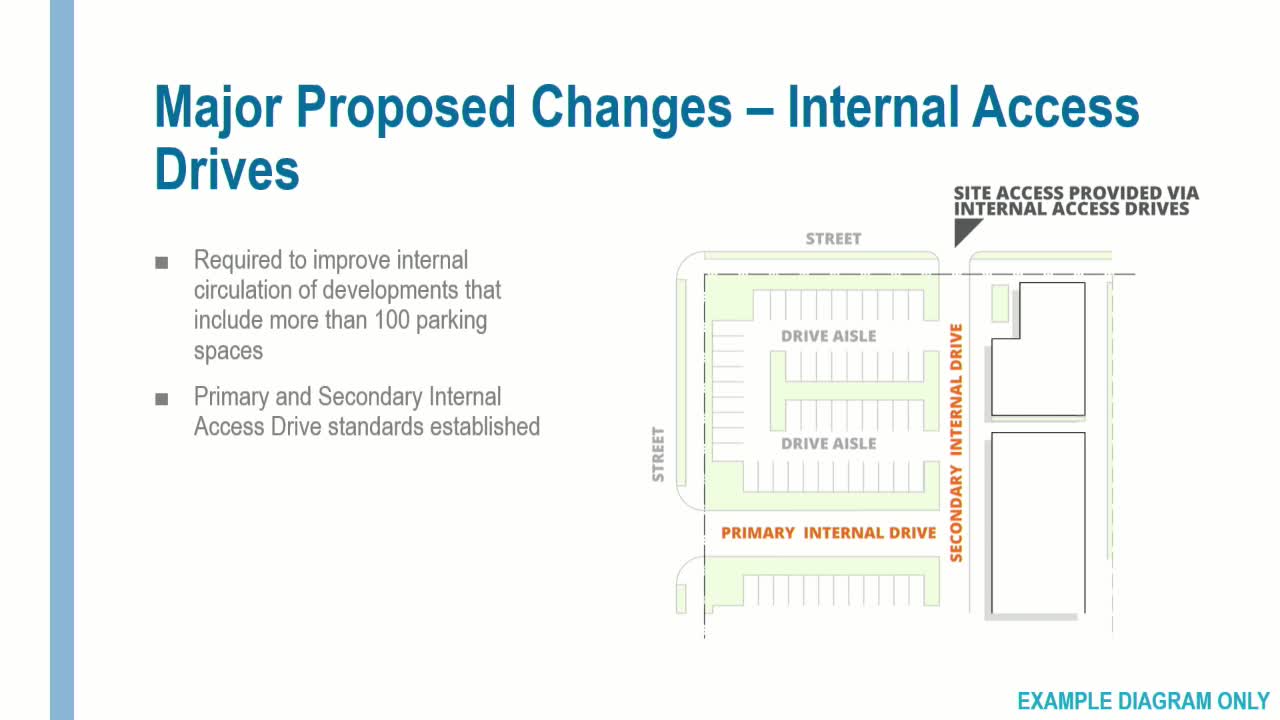Draft parking and access rules would require internal drives for large sites, add parking maximums
October 29, 2025 | Waukesha City, Waukesha County, Wisconsin
This article was created by AI summarizing key points discussed. AI makes mistakes, so for full details and context, please refer to the video of the full meeting. Please report any errors so we can fix them. Report an error »

Hema and staff walked commissioners through proposed access and mobility standards that cover internal access drives, vehicle and bicycle parking, driveways and pedestrian circulation.
Major proposals
- Internal access drives: The draft would require primary and secondary internal drive elements for developments that are 5 acres or larger or that contain more than 100 parking spaces. Primary drives would include travel lanes, planted medians, curb and gutter, parkways (landscape strips between sidewalks and curbs) and sidewalks on both sides; secondary drives would typically require a travel lane, curb and gutter, parkway and a sidewalk on one side.
- Parking minimums and maximums: Staff said the table in the draft reduces many parking minimums to reflect modern demand and includes a maximum across the board that is 50% higher than the minimum for each use to curb overbuilding of asphalt. Staff also proposed administrative adjustments for reductions in parking where a project preserves trees, is proximate to transit, provides shared parking, includes affordable units or submits a parking study.
- Bicycle parking and ADA: Nonresidential and mixed-use buildings must provide short-term visitor bicycle parking; multifamily buildings with five or more units must provide long-term resident bicycle storage. Commissioners were reminded that accessible parking counts and configuration are subject to federal ADA requirements and are reviewed under building/inspection codes.
Debate highlights
Commissioners disagreed on whether primary/secondary internal drives improve safety and circulation or simply increase impervious surface and maintenance burdens (snow, landscaping). Some commissioners favored internal roads and medians to reduce chaotic circulation; others preferred simpler layouts that reduce asphalt area and increase developable land. Staff noted that the diagrams shown were illustrative and that final guidance will be tailored to Waukesha’s context.
What remains unresolved
- Specific dimensional standards and planting requirements for internal drives and medians will be refined with landscape and public-works input.
- How to balance fewer parking stalls (to reduce impervious area) with peak-demand needs for retail/seasonal shopping; staff noted the proposed maximums and administrative adjustments are intended to manage that balance.
Ending
Staff said they will return with detailed diagrams and refined parking tables, including draft maximums and the administrative-adjustment process.
Major proposals
- Internal access drives: The draft would require primary and secondary internal drive elements for developments that are 5 acres or larger or that contain more than 100 parking spaces. Primary drives would include travel lanes, planted medians, curb and gutter, parkways (landscape strips between sidewalks and curbs) and sidewalks on both sides; secondary drives would typically require a travel lane, curb and gutter, parkway and a sidewalk on one side.
- Parking minimums and maximums: Staff said the table in the draft reduces many parking minimums to reflect modern demand and includes a maximum across the board that is 50% higher than the minimum for each use to curb overbuilding of asphalt. Staff also proposed administrative adjustments for reductions in parking where a project preserves trees, is proximate to transit, provides shared parking, includes affordable units or submits a parking study.
- Bicycle parking and ADA: Nonresidential and mixed-use buildings must provide short-term visitor bicycle parking; multifamily buildings with five or more units must provide long-term resident bicycle storage. Commissioners were reminded that accessible parking counts and configuration are subject to federal ADA requirements and are reviewed under building/inspection codes.
Debate highlights
Commissioners disagreed on whether primary/secondary internal drives improve safety and circulation or simply increase impervious surface and maintenance burdens (snow, landscaping). Some commissioners favored internal roads and medians to reduce chaotic circulation; others preferred simpler layouts that reduce asphalt area and increase developable land. Staff noted that the diagrams shown were illustrative and that final guidance will be tailored to Waukesha’s context.
What remains unresolved
- Specific dimensional standards and planting requirements for internal drives and medians will be refined with landscape and public-works input.
- How to balance fewer parking stalls (to reduce impervious area) with peak-demand needs for retail/seasonal shopping; staff noted the proposed maximums and administrative adjustments are intended to manage that balance.
Ending
Staff said they will return with detailed diagrams and refined parking tables, including draft maximums and the administrative-adjustment process.
View the Full Meeting & All Its Details
This article offers just a summary. Unlock complete video, transcripts, and insights as a Founder Member.
✓
Watch full, unedited meeting videos
✓
Search every word spoken in unlimited transcripts
✓
AI summaries & real-time alerts (all government levels)
✓
Permanent access to expanding government content
30-day money-back guarantee

